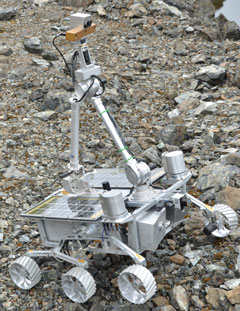Mission Systems

Kapvik exploring an open pit asbestos mine by remote control. The robotic mast has a changeable end unit - here, a scoop for soil collection. Other options include drills or grasp units.
KAPVIK
Smart Reconfigurable All Terrain Multi-Mission microRover
MPB was the prime contractor leading the development of the Smart Reconfigurable All Terrain Multi-Mission microRover for the Canadian Space Agency. Named Kapvik after the Canadian wolverine, the microRover is designed around a modular architecture to allow optimal reconfiguration for lunar and Mars exploration and science.
Kapvik employs a number of Canadian innovations in robotics, sensors, micro-satellites and real-time intelligent software. These provide for in situ analysis of mineralogy, water/ice content, and planetary bio-indicators - all within its 40 kg mass budget.
Kapvik can operate independently for low-cost planetary exploration, or as a collaborative assistant to benefit manned and large rover missions. Its small size allows it to maneuver into tighter corners, and crevices, making it the perfect sidekick to the larger rovers.
Autonomously, Kapvik uses its stereo cameras to scout the terrain, then compiles 3D maps in order to chart a path from point A to point B. Once at its destination, the mast that holds its "eyes" extends to a robotic arm with replaceable "hand" for scooping or drilling samples, or digging trenches.
 Key Kapvik features include:
Key Kapvik features include:
- Travel range greater than 500 m
- Unaided operations on slopes up to 30 degrees
- Tethered operations on steep slopes up to 65 degrees
- A rocker-bogie chassis design with dynamic traction control
- Robotic mast
- in locked position: provides a stable support for the stereo vision navigation sensors
- in unlocked position: provides a four degrees of freedom robotic arm with interchangeable end effector
- Multi-spectral imaging UV-Vis/IR sensors for in situ analysis and 2-D mapping of mineralogy, water/ice content and planetary resources
All components utilized in the construction of Kapvik had to be flight-representative, enabling a path-to-flight qualification should the need arise.
Other organizations involved in the development of Kapvik were: University of Winnipeg, Arizona State University, Carleton University, McGill University, MDA, the University of Toronto, UQAM, Ryerson University, and Xiphos Technologies Inc.
See Concept Missions / Mars Methane Analogue Mission
See Concept Missions / Canadian American British Lunar Explorer
